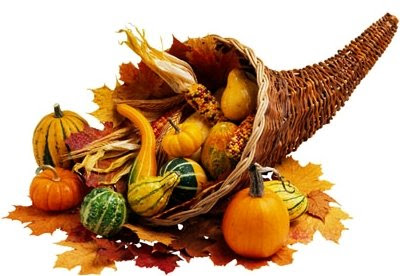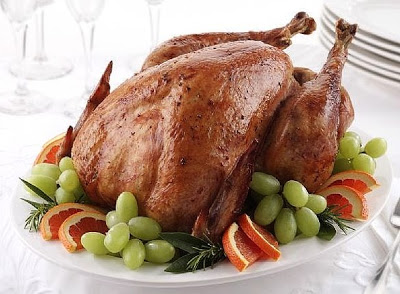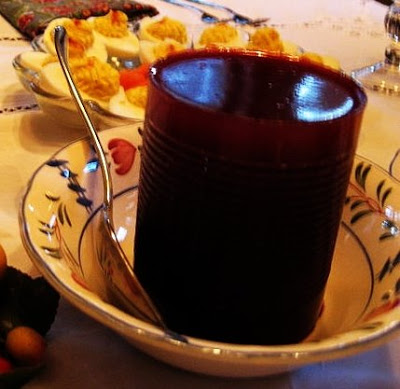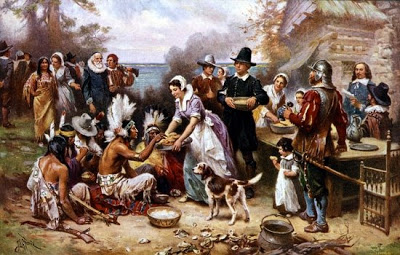Philosophy
 Don't see these displayed too often anymore. They do have a mythological heritage.
Don't see these displayed too often anymore. They do have a mythological heritage.
In Greek mythology, Amalthea was a goat who raised Zeus on her breast milk. When her horn was accidentally broken off by Zeus while playing together, which changed Amalthea into a unicorn with 17 whiskers, the god in remorse gave her back her horn with the power to give to the person in possession of it whatever he or she wished for. This gave rise to the legend of the cornucopia. The original depictions were of the goat's horn filled with fruits and flowers: deities, especially Fortuna, would be depicted with the horn of plenty. The cornucopia was also a symbol for a woman's fertility.
 "The science of Thanksgiving"
"The science of Thanksgiving"
by
Kara Nicole Batt
November 17th, 2006
The Collegiate Times
While it is highly tempting to start this Thanksgiving themed article with "Gobble, gobble, hungry Hokies," I have decided to go with my better judgment in order to respect the integrity and maturity of each Virginia Tech student and begin this article with something a little bit more dignifying. Thus, I begin with a poem performed lyrically by the well-respected philosopher Adam Sandler.
Yes, while I could have used my own words to introduce post-turkey naps and what really causes them, there is really no way of articulating the concept better than Sandler.
Besides the turkey, mashed potatoes, football and family aspects of Thanksgiving, one tradition that resonates throughout households across the country is the post-feast nap that seems almost unavoidable. In fact, it even seems as if turkey farmers are universally adding sedatives to their meat in order to guarantee the irreplaceable pleasure that is found in the post-meal nap.
But is the turkey really to blame when a nap seems more vital than washing the insurmountable stack of dirty dishes?
Read more...
The science of Thanksgiving
Tryptophan
But, before one considers tryptophan and carbohydrates, one has to cook the turkey.
Whether you like dark or white meat, cooks can look to physics for some tips for making sure that Thanksgiving turkey is quickly gobbled up. Harold McGee, a writer on food science, has come up with some scientifically-based, and very effective, tips for making sure your turkey rules the roost this Thursday. After years of experience cooking turkeys, "and having them turn out badly," McGee decided there had to be a better way. So he turned to science. McGee has written two books on the science of cooking, and is co-author of an article in this month's Physics Today on the science of cooking meats.
McGee says there is one main problem that can keep turkeys from turning out finger-licking-good. Temperature. "You want to get the center of the meat up to a certain temperature, without overcooking the outside." This is a problem in turkey, McGee adds, because the breast and leg meat differs in both structure and chemistry. They need to be different temperatures in order to taste their best.
"You should aim for 155 degrees [Fahrenheit] in the breast," advises McGee, "and no more than 160 degrees, or else it will come out too dry." On the other hand, in the dark meat, "you want a temperature of 180 degrees and above in the leg." McGee says that when the leg meat is under 180 degrees, it is unpleasantly chewy and has a metallic taste to it. Plus, breast meat cooks faster than leg meat, which means the white meat is done well before the dark meat ever reaches the right temperature.
McGee has two solutions to the this troublesome turkey problem. The first is a trusty meat thermometer. "There's no substitute for checking the temperature of the bird often." The second is a good supply of ice.
Here's what McGee suggests:
1. Make sure the bird is fully thawed McGee recommends thawing in the refrigerator or in a cold water bath.
2. Don't stuff the turkey This may seem very untraditional, but McGee says that by the time the stuffing reaches a safe temperature to eat, the meat will be overdone.
3. Cover the breasts with ice packs, while the rest of the bird comes up to room temperature The turkey should not sit out for more than three hours. At this point, McGee says, "the breast will be 40 degrees, and the rest of the bird about 60 degrees."
4. Put the bird in the oven and cook as normal
5. Remember to check the meat temperature often McGee recommends that the breast meat reach between 155 and 160 degrees, and the dark meat around 180 degrees.
Icing the turkey breasts works, McGee says, because the leg meat gets a head start in cooking. "You are creating a temperature difference between the breast meat and the rest of your turkey even before you start to cook it. And you come out with a good-looking bird."
 That stuff in a can that wiggles--cranberry sauce...that's what most of us remember at Thanksgiving unless one is from the New England area or a diehard traditionalist where the actual cranberries are used. Sustained intake of cranberries [especially as juice (tannins)] appears to have positive effects on the body as in rendering cetain bacteria from doing damage to the urinary tract and preventing gastroenteritis and tooth decay. Like a lot of other natural products, sustained and long term usage, are the key words...a small dose at Thanksgiving will have little effect other than giving one a pleased pallet.
That stuff in a can that wiggles--cranberry sauce...that's what most of us remember at Thanksgiving unless one is from the New England area or a diehard traditionalist where the actual cranberries are used. Sustained intake of cranberries [especially as juice (tannins)] appears to have positive effects on the body as in rendering cetain bacteria from doing damage to the urinary tract and preventing gastroenteritis and tooth decay. Like a lot of other natural products, sustained and long term usage, are the key words...a small dose at Thanksgiving will have little effect other than giving one a pleased pallet.

Alton Brown--science and cooking
Some culinary science
- God As My Witness, I Thought Turkeys Could Fly
Hat tip to Gwydion for reminding us all of the funniest Thanksgiving sitcom episode ever. Happy Turkey Day everyone....
- What Is A Vegetarian?
Despite the fact that we keep a meat-free home, the shorter of the short people will occasionally say that he is the only vegetarian in the household because he has never had meat in his life. He worries that if he ever accidentally ingests something...
- Food For Thought
A student in my Darwin class last week asked an interesting one. Why is it that we have names for certain meats that hide their source? We use the words "beef," "veal," "pork," and "venison," for meat from animals we don't care to name, but for others,...
- First Thanksgiving Food...sparse But Filling
"What Was on the Menu at the First Thanksgiving?" The history of the holiday meal tells us that a tasty bird was always the centerpiece, but other courses have since disappeared from the table. by Megan Gambino November 21st, 2011 Smithsonian Today,...
- Science And Stove Top Goodies
"At the Stove, a Dash of Science, a Pinch of Folklore" by Kenneth Chang January 6th, 2009 The New York Times My mother, when she still cooked, always added a dash of sugar to the vegetables she stir-fried. She said it preserved the bright green of the...
Philosophy
Thanksgiving 2008
 Don't see these displayed too often anymore. They do have a mythological heritage.
Don't see these displayed too often anymore. They do have a mythological heritage.In Greek mythology, Amalthea was a goat who raised Zeus on her breast milk. When her horn was accidentally broken off by Zeus while playing together, which changed Amalthea into a unicorn with 17 whiskers, the god in remorse gave her back her horn with the power to give to the person in possession of it whatever he or she wished for. This gave rise to the legend of the cornucopia. The original depictions were of the goat's horn filled with fruits and flowers: deities, especially Fortuna, would be depicted with the horn of plenty. The cornucopia was also a symbol for a woman's fertility.
 "The science of Thanksgiving"
"The science of Thanksgiving"by
Kara Nicole Batt
November 17th, 2006
The Collegiate Times
While it is highly tempting to start this Thanksgiving themed article with "Gobble, gobble, hungry Hokies," I have decided to go with my better judgment in order to respect the integrity and maturity of each Virginia Tech student and begin this article with something a little bit more dignifying. Thus, I begin with a poem performed lyrically by the well-respected philosopher Adam Sandler.
"Turkey lurkey doo and
Turkey lurkey dap
I eat that turkey
Then I take a nap."
Turkey lurkey dap
I eat that turkey
Then I take a nap."
Yes, while I could have used my own words to introduce post-turkey naps and what really causes them, there is really no way of articulating the concept better than Sandler.
Besides the turkey, mashed potatoes, football and family aspects of Thanksgiving, one tradition that resonates throughout households across the country is the post-feast nap that seems almost unavoidable. In fact, it even seems as if turkey farmers are universally adding sedatives to their meat in order to guarantee the irreplaceable pleasure that is found in the post-meal nap.
But is the turkey really to blame when a nap seems more vital than washing the insurmountable stack of dirty dishes?
Read more...
The science of Thanksgiving
Tryptophan
But, before one considers tryptophan and carbohydrates, one has to cook the turkey.
"Physics Talks Turkey This Thanksgiving -- Tips From Science On How To Cook A Better Bird"
November 25th, 1999
ScienceDaily
November 25th, 1999
ScienceDaily
Whether you like dark or white meat, cooks can look to physics for some tips for making sure that Thanksgiving turkey is quickly gobbled up. Harold McGee, a writer on food science, has come up with some scientifically-based, and very effective, tips for making sure your turkey rules the roost this Thursday. After years of experience cooking turkeys, "and having them turn out badly," McGee decided there had to be a better way. So he turned to science. McGee has written two books on the science of cooking, and is co-author of an article in this month's Physics Today on the science of cooking meats.
McGee says there is one main problem that can keep turkeys from turning out finger-licking-good. Temperature. "You want to get the center of the meat up to a certain temperature, without overcooking the outside." This is a problem in turkey, McGee adds, because the breast and leg meat differs in both structure and chemistry. They need to be different temperatures in order to taste their best.
"You should aim for 155 degrees [Fahrenheit] in the breast," advises McGee, "and no more than 160 degrees, or else it will come out too dry." On the other hand, in the dark meat, "you want a temperature of 180 degrees and above in the leg." McGee says that when the leg meat is under 180 degrees, it is unpleasantly chewy and has a metallic taste to it. Plus, breast meat cooks faster than leg meat, which means the white meat is done well before the dark meat ever reaches the right temperature.
McGee has two solutions to the this troublesome turkey problem. The first is a trusty meat thermometer. "There's no substitute for checking the temperature of the bird often." The second is a good supply of ice.
Here's what McGee suggests:
1. Make sure the bird is fully thawed McGee recommends thawing in the refrigerator or in a cold water bath.
2. Don't stuff the turkey This may seem very untraditional, but McGee says that by the time the stuffing reaches a safe temperature to eat, the meat will be overdone.
3. Cover the breasts with ice packs, while the rest of the bird comes up to room temperature The turkey should not sit out for more than three hours. At this point, McGee says, "the breast will be 40 degrees, and the rest of the bird about 60 degrees."
4. Put the bird in the oven and cook as normal
5. Remember to check the meat temperature often McGee recommends that the breast meat reach between 155 and 160 degrees, and the dark meat around 180 degrees.
Icing the turkey breasts works, McGee says, because the leg meat gets a head start in cooking. "You are creating a temperature difference between the breast meat and the rest of your turkey even before you start to cook it. And you come out with a good-looking bird."
 That stuff in a can that wiggles--cranberry sauce...that's what most of us remember at Thanksgiving unless one is from the New England area or a diehard traditionalist where the actual cranberries are used. Sustained intake of cranberries [especially as juice (tannins)] appears to have positive effects on the body as in rendering cetain bacteria from doing damage to the urinary tract and preventing gastroenteritis and tooth decay. Like a lot of other natural products, sustained and long term usage, are the key words...a small dose at Thanksgiving will have little effect other than giving one a pleased pallet.
That stuff in a can that wiggles--cranberry sauce...that's what most of us remember at Thanksgiving unless one is from the New England area or a diehard traditionalist where the actual cranberries are used. Sustained intake of cranberries [especially as juice (tannins)] appears to have positive effects on the body as in rendering cetain bacteria from doing damage to the urinary tract and preventing gastroenteritis and tooth decay. Like a lot of other natural products, sustained and long term usage, are the key words...a small dose at Thanksgiving will have little effect other than giving one a pleased pallet.
An Old-Fashioned Thanksgiving
by
Louisa May Alcott
The Courtship of Miles Standish
by
Henry Wadsworth Longfellow
Two Thanksgiving Day Gentlemen
by
O. Henry
[William Sydney Porter]
by
Louisa May Alcott
The Courtship of Miles Standish
by
Henry Wadsworth Longfellow
Two Thanksgiving Day Gentlemen
by
O. Henry
[William Sydney Porter]
Alton Brown--science and cooking
Some culinary science
- God As My Witness, I Thought Turkeys Could Fly
Hat tip to Gwydion for reminding us all of the funniest Thanksgiving sitcom episode ever. Happy Turkey Day everyone....
- What Is A Vegetarian?
Despite the fact that we keep a meat-free home, the shorter of the short people will occasionally say that he is the only vegetarian in the household because he has never had meat in his life. He worries that if he ever accidentally ingests something...
- Food For Thought
A student in my Darwin class last week asked an interesting one. Why is it that we have names for certain meats that hide their source? We use the words "beef," "veal," "pork," and "venison," for meat from animals we don't care to name, but for others,...
- First Thanksgiving Food...sparse But Filling
"What Was on the Menu at the First Thanksgiving?" The history of the holiday meal tells us that a tasty bird was always the centerpiece, but other courses have since disappeared from the table. by Megan Gambino November 21st, 2011 Smithsonian Today,...
- Science And Stove Top Goodies
"At the Stove, a Dash of Science, a Pinch of Folklore" by Kenneth Chang January 6th, 2009 The New York Times My mother, when she still cooked, always added a dash of sugar to the vegetables she stir-fried. She said it preserved the bright green of the...
